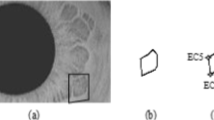Abstract
The culmination of technology-driven society has bought individuals in a lot of digital transactions. How legitimate these transactions are, is the question of the hour. Biometric-enabled transactions have gained popularity. Sclera, a new biometric-based recognition system promises to add value to such transactions. However, this recognition is purely based on the effective segmentation of the sclera from the occluded region of the eye. This work proposes a Modified Intuitionistic Fuzzy Clustering approach for the effective segmentation of sclera images. The traditional fuzzy set assumes that the non-membership value is always the complement of the membership value. But in the true sense, this assumption is not always correct because of hesitation. To alleviate the problems of hesitation degree and noise in the images, the Modified Intuitionistic Fuzzy C-Means (MIFCM) is proposed and tested against the Sclera Segmentation and Recognition Benchmarking Competition (SSRBC2016) and Sclera Segmentation Benchmarking Competition (SSBC 2019) dataset. The experimentation results reveal that the proposed work complements the other existing methods and variants of Fuzzy C-Means.


Similar content being viewed by others
References
Joussen AM. Vascular plasticity–the role of the angiopoietins in modulating ocular angiogenesis. Graefes Arch Clin Exp Ophthalmol. 2001;239(12):972–5.
Das A, Pal U, Blumenstein M, Ballester MAF. Sclera recognition-a survey. In: 2013 2nd IAPR Asian Conference on Pattern Recognition, IEEE, 2013, pp. 917–21.
Ng HP, Ong SH, Foong KWC, Goh PS, Nowinski WL. Medical image segmentation using k-means clustering and improved watershed algorithm. In: 2006 IEEE Southwest Symposium on Image Analysis and Interpretation IEEE, 2006, pp. 61–5.
Chen CW, Luo J, Parker KJ. Image segmentation via adaptive K-mean clustering and knowledge-based morphological operations with biomedical applications. IEEE Trans Image Process. 1998;7(12):1673–83.
Wan W, Zhang Y, Li Y, Zhang X. The global fuzzy c-means clustering algorithm. In: 2006 6th World Congress on Intelligent Control and Automations, IEEE, pp. 3604–07.
Hadjahmadi AH, Homayounpour MM, Ahadi SM. Robust weighted fuzzy c-means clustering. In: 2008 IEEE International Conference on Fuzzy Systems (IEEE World Congress on Computational Intelligence), IEEE, pp. 305–11.
Thomas NL, Du Y, Zhou Z. A new approach for sclera vein recognition. In: Mobile multimedia/image processing, security, and applications. Washington: International Society for Optics and Photonics; 2010. p. 770805.
Fan CP, Gu TW, He SY. Feature-based blood vessel structure rapid matching and support vector machine-based sclera recognition with effective sclera segmentation. In: Advances in biometrics. Cham: Springer; 2019. p. 73–90.
Gokul Rajan V, Vijayalakshmi S. A new approach for sclera segmentation using integro differential operator. J Comput Theor Nanosci. 2020;17(5):2330–5.
Alkassar S, Woo WL, Dlay SS, Chambers JA. Enhanced segmentation and complex-sclera features for human recognition with unconstrained visible-wavelength imaging. In: 2016 International Conference on Biometrics (ICB), IEEE, pp. 1–8.
Das A, Pal U, Ferrer MA, Blumenstein M. SSRBC 2016: Sclera segmentation and recognition benchmarking competition. In: 2016 International Conference on Biometrics (ICB), IEEE, pp. 1–6.
Das A, Umapada P, Michael B, Caiyong Wa, Yong H, Yuhao Z, Zhenan S. Sclera segmentation benchmarking competition in cross-resolution environment. In: 2019 International Conference on Biometrics (ICB), IEEE, 2019, pp. 1–7.
Abhijit D, Umapada P, Miguel AF, Blumenstein M. SSBC 2015: sclera segmentation benchmarking competition. In: IEEE 7th International Conference on Biometrics Theory, Applications and Systems, BTAS, 2015, pp. 1–6.
Das A, Pal U, Ferrer MA, Blumenstein M, Štepec D, Rot P, Harish BS. SSERBC 2017: sclera segmentation and eye recognition benchmarking competition. In: 2017 IEEE International Joint Conference on Biometrics (IJCB), IEEE, pp. 742–7.
Vitek M, Das A, Pourcenoux Y, Missler A, Paumier C, Das S, Štruc V. SSBC 2020: sclera segmentation benchmarking competition in the mobile environment. In: 2020 IEEE International Joint Conference on Biometrics (IJCB), IEEE, pp. 1–10.
Atanassov KT. Intuitionistic fuzzy sets. Fuzzy Sets Syst. 1986;20(1):87–96.
Sugeno M, Terano T. A model of learning based on fuzzy information. Kybernetes. 1977;6(3):157–66.
Yager RR. On the measure of fuzziness and negation part i: membership in the unit interval. Int J Gen Syst. 1979;5(4):221–9.
Chaira T. A novel intuitionistic fuzzy c means clustering algorithm and its application to medical images. Appl Soft Comput. 2011;11(2):1711–7.
Zhang H, Xu Z, Chen Q. On clustering approach to intuitionistic fuzzy sets. Control Decis. 2007;22(8):882–90.
Xu Z, Chen J, Wu J. Clustering algorithm for intuitionistic fuzzy sets. Inf Sci. 2008;178(19):3775–90.
Lin K. A novel evolutionary kernel intuitionistic fuzzy c-means clustering algorithm. IEEE Trans Fuzzy Syst. 2014;22(5):1074–87.
Chaudhuri A. Intuitionistic fuzzy possibilistic c means clustering algorithms. Adv Fuzzy Syst. 2015;2015:1–17.
Szmidt E, Kacprzyk J. On measuring distances between intuitionistic fuzzy sets. Notes on IFS. 1997;3(4):1–3.
Szmidt E, Kacprzyk J. Distances between intuitionistic fuzzy sets. Fuzzy Sets Syst. 2000;114(3):505–18.
Szmidt E, Kacprzyk J. Intuitionistic fuzzy sets in some medical applications. Note IFS. 2001;7(4):58–64.
Hung W, Yang M. Similarity measures of intuitionistic fuzzy sets based on hausdor distance. Pattern Recogn Lett. 2004;25(14):1603–11.
Huttenlocher DP, Klanderman GA, Rucklidge WJ. Comparing images using the hausdor distance. IEEE Trans Pattern Anal Mach Intell. 1993;15(9):850–63.
Bustince H, Kacprzyk J, Mohedano V. Intuitionistic fuzzy generators application to intuitionistic fuzzy complementation. Fuzzy Sets Syst. 2000;114(3):485–504.
Chen S, Zhang D. “Robust image segmentation using FCM with spatial constraints based on new kernel-induced distance measure. IEEE Trans Syst Man Cybern Part B. 2004;34(4):1907–16.
Jin X, Lin T, Liao L, Wang T. Multi-spectral MRI brain image segmentation based on kernel clustering analysis. Int Conf Syst Eng Model. 2012;34:141–6.
Kumar SA, Harish BS. Segmenting mri brain images using novel robust spatial kernel fcm (rskfcm). In: Eighth International Conference on Image and Signal Processing, 2014, pp. 38–44.
Maheshan MS, Harish BS, Aruna SVK. Sclera segmentation using spatial kernel fuzzy clustering methods. In: ICPRAM, 2020, pp. 433–9.
Author information
Authors and Affiliations
Corresponding author
Ethics declarations
Conflict of Interest
The authors declare that they have no conflict of interest.
Additional information
Publisher's Note
Springer Nature remains neutral with regard to jurisdictional claims in published maps and institutional affiliations.
Rights and permissions
About this article
Cite this article
Maheshan, M.S., Harish, B.S. A Modified Intuitionistic Fuzzy Clustering Approach for Sclera Segmentation. SN COMPUT. SCI. 2, 327 (2021). https://doi.org/10.1007/s42979-021-00722-5
Received:
Accepted:
Published:
DOI: https://doi.org/10.1007/s42979-021-00722-5




